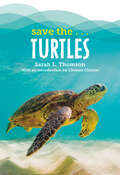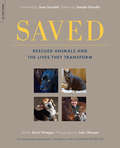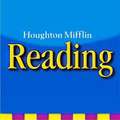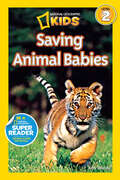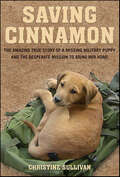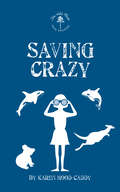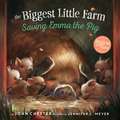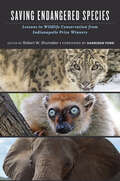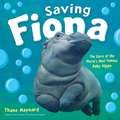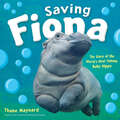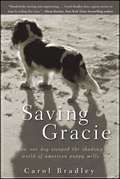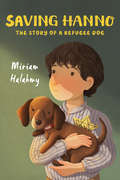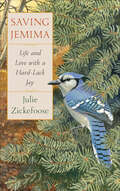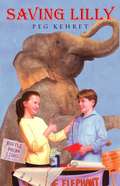- Table View
- List View
Save the...Tigers (Save the...)
by Christine Taylor-Butler Chelsea ClintonTigers have roared and pounced their ways into kids' hearts. With this book, readers can become tiger experts and learn how to save the animals they love. Featuring an introduction from Chelsea Clinton!Did you know that a tiger roar can be heard from two miles away? Or that tiger saliva prevents infection? Or how about that a tiger's urine smells like buttered popcorn? Perfect for all animal lovers--and tiger fans in particular--this book is filled with information that young readers will love to learn. From where tiger habitats are found to what it's like to be a tiger to why tigers are endangered and who has been working hard to save them, this gives readers all the facts they know to become tiger experts.Complete with black-and-white photographs, a list of fun tiger facts, and things that kids can do right this very moment to help save tigers from extinction, this book, with an introduction by animal advocate Chelsea Clinton, is a must for every family, school, and community library.
Save the...Turtles (Save the...)
by Sarah L. Thomson Chelsea ClintonTurtles have swum and snapped their ways into kids' hearts. With this book, readers can become turtle experts and learn how to save the animals they love. Featuring an introduction from Chelsea Clinton!Did you know that a turtle named Jonathan is the oldest known living animal on Earth? (He&’s almost two hundred!) How about that the largest sea turtles can dive more than three thousand feet below the water&’s surface? Or that turtles&’ shells have a spine in them, which makes turtles vertebrates—just like humans?Perfect for all animal lovers—and turtle fans in particular—this book is filled with all the facts you need to know to become a turtle expert! Where are turtles found? What&’s it like to be a turtle? Why are turtles endangered, and who has been working hard to save them? Read this book and find out how you can help save the turtles!Complete with black-and-white photographs, a list of fun turtle facts, and things that kids can do right this very moment to help save turtles from extinction, this book, with an introduction by animal advocate Chelsea Clinton, is a must for every family, school, and community library.
Save the...Whale Sharks (Save the...)
by Chelsea Clinton Anita SanchezWhale sharks have swum and chomped their ways into kids' hearts. With this book, readers can become whale shark experts and learn how to save the animals they love. Featuring an introduction from Chelsea Clinton!Did you know that whale sharks are sometimes called domino fish because of the spots on their backs? How about that the smallest recorded whale shark was only fifteen inches long? Or that whale sharks have teeth on their eyes? Perfect for all animal lovers--and whale shark fans in particular--this book is filled with information that young readers will love to learn. From where whale shark habitats are found to what it's like to be a whale shark to why whale sharks are endangered and who has been working hard to save them, this book gives readers all the facts they know to become whale shark experts.Complete with black-and-white photographs, a list of fun whale shark facts, and things that kids can do right this very moment to help save whale sharks from extinction, this book, with an introduction by animal advocate Chelsea Clinton, is a must for every family, school, and community library.
Saved from a Wildfire (Fountas & Pinnell Classroom)
by Alice CaryWolves in Trouble Firefighters fighting a huge wildfire in Alaska discover five injured wolf pups. Can the young wolves be saved? NIMAC-sourced textbook
Saved: Rescued Animals and the Lives They Transform
by Karin Winegar Judy OlausenLauded as "an extraordinarily poignant book" by Jim Harrison and called "an homage to the profound power of mutual healing" and a "definitive and compassionate book" by Susan Richards (author of Chosen by a Horse), Saved is a beautifully illustrated tribute to rescued animals who have deeply affected the people who saved them. From Phil, an ailing and unemployed foster dad to an orphaned fawn, to Walt, a retired pipe fitter whose horses helped alleviate his heartache after the death of his son, the stories in Saved, as Rita Mae Brown says, "prove once again that love rescues us all."
Saving America's Wild Horses (Houghton Mifflin Harcourt Vocabulary Readers #Leveled Reader: Level: 5, Theme: 5.3)
by Deborah HarrisonIntroduction to the wild horses that once roamed North America after their introduction by the Spanish in the 1500s.
Saving Animal Babies (National Geographic Kids Readers)
by Amy ShieldsThese heartwarming stories of animal babies, rescued and nursed back to health by humans, will pull at the heart strings and make kids realize there's a survivor inside all of us. This reader is illustrated with adorable photographs that document these animals' recoveries. The carefully written text guarantees a successful and rewarding reading experience for level 1 readers.National Geographic supports K-12 educators with ELA Common Core Resources.Visit www.natgeoed.org/commoncore for more information.
Saving Animals: Multispecies Ecologies of Rescue and Care
by Elan AbrellA fascinating and unprecedented ethnography of animal sanctuaries in the United States In the past three decades, animal rights advocates have established everything from elephant sanctuaries in Africa to shelters that rehabilitate animals used in medical testing, to homes for farmed animals, abandoned pets, and entertainment animals that have outlived their &“usefulness.&” Saving Animals is the first major ethnography to focus on the ethical issues animating the establishment of such places, where animals who have been mistreated or destined for slaughter are allowed to live out their lives simply being animals. Based on fieldwork at animal rescue facilities across the United States, Elan Abrell asks what &“saving,&” &“caring for,&” and &“sanctuary&” actually mean. He considers sanctuaries as laboratories where caregivers conceive and implement new models of caring for and relating to animals. He explores the ethical decision making around sanctuary efforts to unmake property-based human–animal relations by creating spaces in which humans interact with animals as autonomous subjects. Saving Animals illustrates how caregivers and animals respond by cocreating new human–animal ecologies adapted to the material and social conditions of the Anthropocene.Bridging anthropology with animal studies and political philosophy, Saving Animals asks us to imagine less harmful modes of existence in a troubled world where both animals and humans seek sanctuary.
Saving Biodiversity: Threats, Strategies, and Big Ideas (Routledge Studies in Conservation and the Environment)
by Matt W. HaywardDrawing on the author's personal experiences working across the globe, this book explains why we need to conserve biodiversity, the threats it faces, how we can successfully conserve biodiversity, and some success stories of how we have conserved it.This is a personal journey from being an environmental vandal to internationally renowned conservationist. The book follows the author’s life and career in conservation, from scarring koala-feed trees to being chased by elephants, sniffed by lions, gored by quokkas, and watched by wolves. It mixes robust facts with fun stories to engage a broad audience spanning the general public to academics and enthuse them into promoting the conservation of the plants and animals humanity relies on. Split into five sections, the first explains why we should conserve Nature and the value it holds. Section 2 discusses the threats to biodiversity, and Section 3 describes the author’s personal experiences in conserving biodiversity, from creating protected areas and managing invasive species, reintroduction programmes, and the social policies we need to enact to ensure biodiversity persists. Section 4 provides examples of conservation success stories from across the globe, and the book concludes by looking at the big picture issues society needs to address to ensure that future generations get to experience the same degree of beauty of the natural world that we have.This book is a must read for all concerned with conserving Nature and sustaining our planet.
Saving Cinnamon: The Amazing True Story of a Missing Military Puppy and the Desperate Mission to Bring Her Home
by Christine SullivanSet against the backdrop of the war in Afghanistan, Saving Cinnamon chronicles the love story of Navy Reservist Mark Feffer and a stray puppy he bonded with while stationed outside of Kandahar. When Mark is about to return stateside, he decides to adopt Cinnamon and sets up her transport back to the U.S. But the unthinkable happens and Cinnamon is abandoned by the dog handler who was supposed to bring her home, and disappears with out a trace. Mark and his family start a desperate search for the puppy which lasts 44 days and ends dramatically when Mark and Cinnamon are finally reunited. This is a touching memoir told by Mark's sister, who initiated the rescue efforts.
Saving Crazy
by Karen Hood-CaddyCan a high-seas, whale-saving adventure repair the hurt between two friends? How do you decide where your heart lies when it’s being tugged at from so many sides? When Robin and Zo-Zo discover that their beloved lake has become a toxic sludge — the result of an algae bloom — they know they have to do something to fix it. But trouble begins when the two friends develop a crush on the same boy during a community meeting to save the lake. To help repair things between the girls, Robin’s grandmother, Griff, suggests a high-seas adventure with a whale-saving old friend of hers. Out on the open water Robin must decide what’s more important: a relationship with a boy or saving the animals she loves.
Saving Emma the Pig (The Biggest Little Farm)
by John ChesterA companion picture book to the award-winning film, "The Biggest Little Farm"!Welcome to Apricot Lane Farm, a unique world full of true stories about heartwarming animals’ relationships and the special people who care for them. When Emma the pig arrives at the Apricot Lane Farm, she is about to give birth to piglets. But she is also sick, and after her seventeen babies arrive, Emma is unable to care for them. Taking care of seventeen piglets and a sick mama pig is a challenge for Farmer John and his team. But the cure for Emma reminds them what is most important—for pigs and for humans: love and friendship. Saving Emma the Pig is a heartfelt picture book from John Chester, with gorgeous illustrations from Jennifer L. Meyer
Saving Endangered Animals (Fountas & Pinnell LLI Red #Level Q)
by Ruth MusgraveWhat is the endangered species list? Three species once nearly extinct, the American alligator, the northern elephant seal, and the bald eagle, are now growing in numbers. What made the difference?
Saving Endangered Species: Lessons in Wildlife Conservation from Indianapolis Prize Winners
by Robert W. ShumakerThe amazing true stories of the greatest wildlife champions of our time.Wildlife conservation is at a critical juncture. While large, charismatic mammals may be the first animals that come to mind—the mere 3,000 wild tigers still in existence, the giraffes declared endangered for the first time just last year—it is not only these magnificent keystone species disappearing. A full third of all studied birds, reptiles, and mammals have suffered devastating population losses, and a third of all insects are now endangered, including crucial pollinators that sustain worldwide food supply. Over 15,000 animal species are now considered to be threatened with extinction. There are, however, bright spots that provide optimism—many of them due to the efforts of a small group of scientists and activists. In Saving Endangered Species, Robert W. Shumaker brings together ten conservation heroes, seven of them winners of the Indianapolis Prize, three of them recipients of the Jane Alexander Global Wildlife Ambassador Award. With moving immediacy, each wildlife defender offers their unique perspective on the state of wildlife conservation and the future of the natural world. Bringing to life their work in the field, each contributor also explains key concepts in wildlife conservation, reveals why they are important, and discusses what kinds of work can be done to address biodiversity loss.Contributors sharing their stories in their own words include• George Schaller, one of the founding fathers of wildlife conservation, who conducted the field work that resulted in the establishment of the world's largest wildlife preserve, the Arctic National Wildlife Refuge• Iain Douglas-Hamilton, who is widely credited with developing the metrics and methods that stemmed the tide of elephant poaching for ivory in Africa• Steven Amstrup, who discovered the disturbing truth that the sea ice polar bears rely on for traveling, hunting, and raising their young was disappearing • Russell Mittermeier, who has discovered over 20 new animal species, conducted field work in more than 30 countries around the globe, and authored 15 books on biodiversity• Harrison Ford, Academy Award–winning actor, who has been a passionate wildlife advocate and board member of Conservation International for over 25 years• Sigourney Weaver, three-time Academy Award nominee, whose work with the Dian Fossey Gorilla Fund has helped save thousands of gorillas in Rwanda and CongoThis unique book aims to win new recruits, inspire biologists and conservationists already in the field, and illustrate the profession's fundamental scientific tenets through wildlife champions' own exciting narratives. Covering issues from reproduction and prey-predator relationships to population dynamics and community engagement, Saving Endangered Species also addresses such thorny topics as overhunting, retaliatory killing by farmers, development-driven habitat loss, and the illegal wildlife trade. By encompassing a broad spectrum of subjects, this volume ultimately gives readers a first-person look into what it takes to dedicate oneself to the crucial field of wildlife conservation.Contributors: Jane Alexander, Steven C. Amstrup, George Archibald, Michael I. Crowther, Iain Douglas-Hamilton, Harrison Ford, Carl Jones, Russell Mittermeier, George B. Schaller, Robert W. Shumaker, Sigourney Weaver, Patricia Chapple Wright
Saving Fiona: The Story of the World's Most Famous Baby Hippo
by Thane MaynardWhen Fiona began to thrive, her star began to rise, and soon she became an internet sensation, her picture and videos garnering thousands and thousands of likes and fans on Instagram and Facebook. Now a Fiona appearance at the Zoo mimics a Beatles concert. What made this little, now big, hippo such a big hit with people all over the world? And what's in store for her and her family in the future.
Saving Fiona: The Story of the World's Most Famous Baby Hippo
by Thane MaynardThe amazing, true story of Fiona, a baby hippo born prematurely at the Cincinnati Zoo, the team of scientists and caregivers who nursed her to health, and the vast community in Cincinnati and beyond who rallied around her. Includes full-color behind-the-scenes photographs throughout. On a cold January day in 2017, nearly two months before due date, Nile hippopotamus Bibi gave her keepers at the Cincinnati Zoo & Botanical Garden a big (little) surprise—a tiny newborn hippo, no bigger than a football. The first premature hippo born and raised in captivity, baby Fiona was an underdog from the start: she couldn't nurse, she couldn't stay hydrated, and she wasn't thriving. But the staff at the zoo knew they could save her. It would take creative thinking and teamwork. They would have to study the makeup of hippo milk for the first time ever and reach out to medical colleagues, including a team at the local Children's Hospital with superior vein-finding skills, to ensure that Fiona would begin to gain weight and become healthy. When Fiona began to thrive, her star began to rise, and soon she became an internet sensation, her picture and videos garnering thousands and thousands of likes and fans on Instagram and Facebook. Now a Fiona appearance at the Zoo mimics a Beatles concert. What made this little, now big, hippo such a big hit with people all over the world? And what's in store for her and her family in the future?
Saving Gracie: How One Dog Escaped the Shadowy World of American Puppy Mills
by Carol BradleyA compelling true story of one dog's rescue from a Pennsylvania puppy mill This touching narrative uses the poignant makeover of Gracie, a sickly Cavalier King Charles Spaniel, to tell the story of America's hidden puppy mills-commercial kennels that breed dogs in horrific living conditions and churn out often-diseased and emotionally damaged puppies for sale. Saving Gracie chronicles how one little dog is transformed from a bedraggled animal worn out from bearing puppies into a loving, healthy member of her new family; and how her owner, Linda Jackson, is changed from a person who barely tolerated dogs to a woman passionately determined not only to save Gracie's life, but also to get the word out about the millions of American puppy mill dogs who need our help. A touching story of survival and redemption Written by award-winning journalist Carol Bradley Newsworthy issues call animal lovers to action Join journalist Carol Bradley as she draws back the curtain on the world of illegal puppy production in Saving Gracie.
Saving Hanno: The Story of a Refugee Dog
by Miriam HalahmyNine-year-old Rudi and his beloved dog Hanno escape from Nazi Germany, but Rudi soon learns he'll have to protect Hanno from an entirely new threat in this thrilling reimagining of a little known World War II event.What if you had to leave your dog behind when you fled? Nine-year-old Rudi has a chance to leave the dangers of Nazi Germany on a Kindertransport to England. However, he cannot bring Hanno, his wonderful dachshund. Luckily, his family finds a way to smuggle Hanno to London. But with England on the brink of war, Hanno is still not safe.As a German invasion of England becomes imminent, many British people decide their pets will suffer as well as drain limited resources, and thousands of pets are euthanized. To save Hanno, Rudi joins a group of scrappy London children who hide their pets away in a vacant lot. Just as London's children are about to be evacuated to the countryside, the group finds a wealthy animal lover willing to care for the menagerie on her country estate. This fast-paced and accessible novel is full of courage and excitement. An author's note gives more information on the real-life events on which this story is based.
Saving Jemima: Life and Love with a Hard-Luck Jay
by Julie Zickefoose“All blue jays have a penchant for stealing, but Jemima will steal your heart. Three cheers for this spunky baby bird.” —Sy Montgomery, New York Times–bestselling authorWhen Jemima, a young orphaned blue jay, is brought to wildlife rehabilitator Julie Zickefoose, she is a virtually tailless, palm-sized bundle of gray-blue fluff. But she is starved and very sick. Julie’s constant care brings her around, and as Jemima is raised for eventual release, she takes over the house and the rest of the author’s summer. Shortly after release, Jemima turns up with a deadly disease. But medicating a free-flying wild bird is a challenge. When the PBS show Nature expresses interest in filming Jemima, Julie must train her to behave on camera, as the bird gets ever wilder. Jemima bonds with a wild jay, stretching her ties with the family. Throughout, Julie grapples with the fallout of Jemima’s illness, studies molt and migration, and does her best to keep Jemima strong and wild. She falls hard for this engaging, feisty and funny bird, a creative muse and source of strength through the author’s own heartbreaking changes.Emotional and honest, Saving Jemima is a universal story of the communion between a wild creature and the human chosen to raise it.“Mixing cute blue-jay stories with scientific facts, the author teaches readers lots of ornithology, and, by adding tales of the simultaneous turmoil her family was undergoing, she shows how nature and animals can heal heartbreak. Zickefoose has produced another hard-to-put-down winner!” —Booklist (starred review) “A heartwarming account for all interested in natural history, especially birds, animal behavior, and wildlife rehabilitation.” —Library Journal
Saving Lilly
by Peg KehretErin Wrenn and her friend David are in trouble as they refuse to go on a field trip to the Glitter Tent Circus. They wrote a report on the sad lives of circus animals, and find that the Glitter Tent Circus is one of the worst animal abusers of all.
Saving Manno: What a Baby Chimp Taught Me About Making the World a Better Place
by Spencer SekyerAn inspiring and uplifting memoir about one small-town teacher’s eye-opening travels around the world and his relentless efforts to rescue a chimp in danger.As a child, Spencer Sekyer’s world was a simple one. He grew up in a small town, where many of his days were spent hunting in the woods and pursuing his dream of becoming a professional athlete. But when his athletic career ended, he found himself seeking new goals. Spencer returned to school and became a teacher. Realizing he still had much to learn about the world, Spencer set out to explore its most dangerous areas. He traveled to Sierra Leone to volunteer in a local school, followed by trips to the West Bank, Afghanistan, and Haiti. Each time, Spencer returned home a little wiser, a little more emotionally mature, and a little more ready to give back to a world that had given him so much. In Duhok, Kurdistan, Spencer’s journey took a new turn. After stumbling into a local zoo, Spencer formed an unlikely bond with Manno, a young chimpanzee who had been kidnapped from his family in central Africa and sold into captivity. Determined to get Manno back to his home, Spencer began to investigate the shadowy, dangerous world of global animal trafficking. Facing resistance at every turn, and with ISIS closing in on Duhok, Spencer finally set in motion an international effort to get his friend to safety, before it was too late. Bursting with compassion, inspiration, and courage, Saving Manno is a testament to the fact that every one of us has the power to change lives and make the world a better place.
Saving Marty
by Paul GriffinFans of Because of Winn Dixie will adore this warm and heart-wrenching story of the friendship between a boy and a pig who thinks it's a dog. <P><P>Eleven-year-old Lorenzo Ventura knows heroes are rare—like his father, who died in the war, or his friend Paloma Lee, who fearlessly pursues her dream of being a famous musician. Renzo would never describe himself as a hero, but his chance comes when he adopts Marty, a runt piglet. <P><P>Marty is extraordinary—he thinks he’s a dog and acts like one too—and his bond with Renzo is truly one of a kind. At first, the family farm seems like the perfect home for Marty, but as he approaches 350 pounds, it becomes harder for Renzo to convince his mom that a giant pig makes a good pet. <P><P>So when Marty causes a dangerous (and expensive) accident, Renzo knows Marty’s time is up. He’d do anything and everything for his best friend, but will everything be enough to save Marty? <P><P>Paul Griffin masterfully melds the heartrending and the hopeful in this unforgettable story about the power of friendship . . . and the unsung heroes all around us.
Saving Migrant Birds: Developing Strategies for the Future (Corrie Herring Hooks Series)
by John FaaborgIn the 1980s, numerous scientific surveys documented both declining bird populations, especially among Neotropical songbirds that winter in the tropics, and the loss of tropical rain forest habitat. Drawing the seemingly obvious conclusion, scientists and environmental activists linked songbird declines to loss of tropical habitats and alerted the world to an impending ecological catastrophe. Their warnings led to the establishment of the Neotropical Migratory Bird Conservation Program, also known as Partners in Flight, the self-proclaimed largest conservation effort in history. Looking back over more than a decade of efforts to save migrant birds, John Faaborg offers the first serious evaluation of the state of songbird populations today, the effectiveness of conservation programs such as Partners in Flight, and the reliability and completeness of scientific research on migrant birds. Taking neither an alarmist nor a complacent approach, he shows that many factors besides habitat loss affect bird populations and that Neotropical migrants as a group are not declining dramatically, though some species adapt to habitat alteration more successfully than others. Faaborg’s state-of-the-art survey thus clarifies the kinds of information we will need and the conservation efforts we should undertake to ensure the long-term survival of Neotropical migrant birds.
Saving Migrant Birds: Developing Strategies for the Future (Corrie Herring Hooks Series)
by John Faaborg&“Rigorous and well defended . . . Faaborg makes many fresh and, in some cases, provocative points regarding management guidelines for migrant birds.&” —Kenneth Able, Great Plains Research In the 1980s, numerous scientific surveys documented both declining bird populations, especially among Neotropical songbirds that winter in the tropics, and the loss of tropical rain forest habitat. Drawing the seemingly obvious conclusion, scientists and environmental activists linked songbird declines to loss of tropical habitats and alerted the world to an impending ecological catastrophe. Their warnings led to the establishment of the Neotropical Migratory Bird Conservation Program, also known as Partners in Flight, the self-proclaimed largest conservation effort in history. Looking back over more than a decade of efforts to save migrant birds, John Faaborg offers the first serious evaluation of the state of songbird populations today, the effectiveness of conservation programs such as Partners in Flight, and the reliability and completeness of scientific research on migrant birds. Taking neither an alarmist nor a complacent approach, he shows that many factors besides habitat loss affect bird populations and that Neotropical migrants as a group are not declining dramatically, though some species adapt to habitat alteration more successfully than others. Faaborg&’s state-of-the-art survey thus clarifies the kinds of information we will need and the conservation efforts we should undertake to ensure the long-term survival of Neotropical migrant birds. &“Presents a carefully and closely reasoned argument about the magnitude of the conservation problems facing migrant birds, how we can reduce these problems, and how current conservation efforts have enormous value even if there is no immediate crisis.&” —Scott K. Robinson, Professor and Head, Department of Animal Biology, University of Illinois
Saving Mister Nibbles (Elliot's Park #1)
by Patrick CarmanMister Nibbles has been captured and taken to the yellow house across the street from Elliot's Park! Elliot and his friends come up with a plan to save Mister Nibbles, because squirrels are not meant to live indoors.

